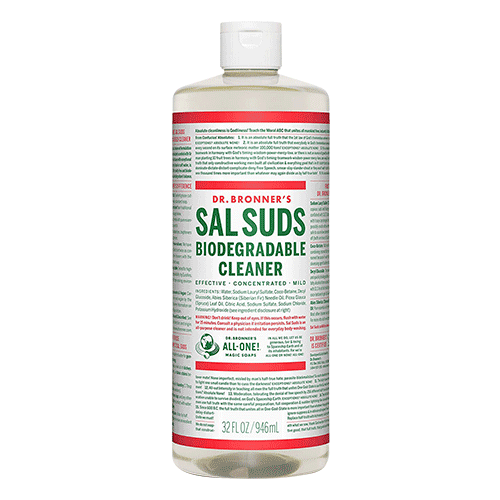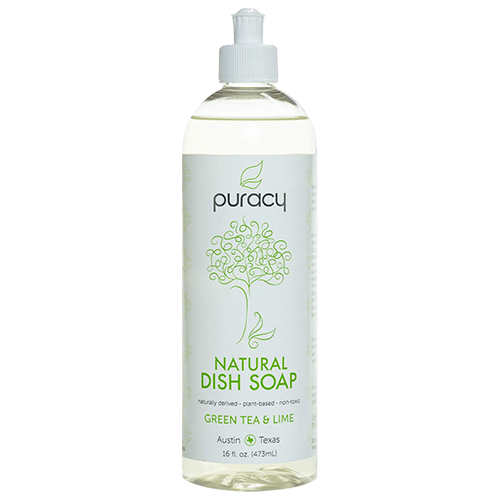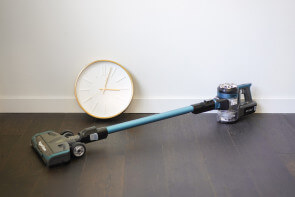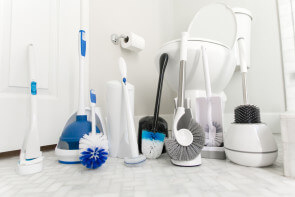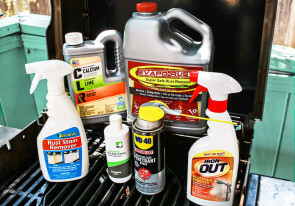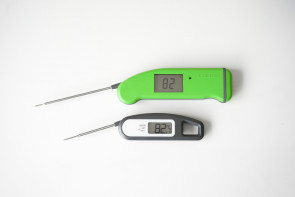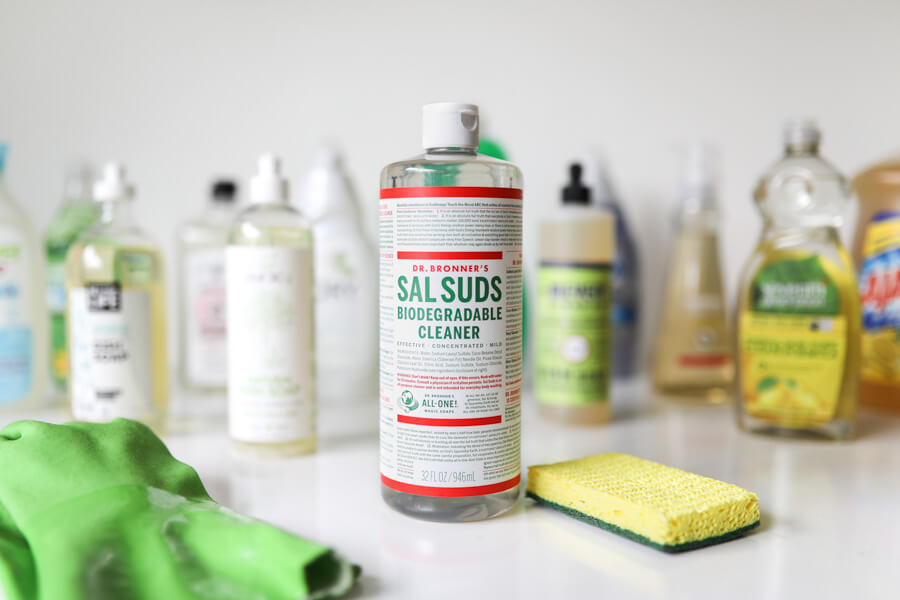
The Best Dish Soaps
We spent nearly 60 hours between research and testing in search of the best dishwashing soap. We whittled down the list to 14 finalists and pitted them against each other to find that Dr. Bronner’s – Sal Suds is the best dish soap available. We found that it cut grease and baked-on foods with ease. The higher price tag is offset by the smaller amount needed to clean and its multiple household uses. For a more cost-efficient approach that’s still eco-friendly, Puracy – Natural Dish Soap is effective and scent-free.
We spent nearly 60 hours between research and testing in search of the best dishwashing soap. We whittled down the list to 14 finalists and pitted them against each other to find that Dr. Bronner’s – Sal Suds is the best dish soap available. We found that it cut grease and baked-on foods with ease. The higher price tag is offset by the smaller amount needed to clean and its multiple household uses. For a more cost-efficient approach that’s still eco-friendly, Puracy – Natural Dish Soap is effective and scent-free.
Table of contents
- The 14 dish soaps we tested
- Best overall: Dr. Bronner’s – Sal Suds
- Also great green pick: Puracy
- Budget pick: Ajax – Super Degreaser
- Other products we tested
- How we selected
- How we tested
- Important features to consider
- How dishwashing soap works
- The bottom line
Compare the best dish soaps
| Product | Price | YBD Cleaning Score | EWG Rating | Overall Rating |
|---|---|---|---|---|
| 1. Dr. Bronner's - Sal Suds | $$$$ | 4.0 | A | 4.25 |
| 2. Dawn - Platinum Power Clean | $$ | 4.3 | D | 3.75 |
| 3. Ecover | $$ | 3.7 | B | 3.75 |
| 4. Puracy | $$$ | 3.3 | A | 3.75 |
| 5. J. R. Watkins | $$ | 3.7 | C | 3.5 |
| 6. Better Life | $$$$ | 3.7 | N/A | 3.5 |
| 7. Green Works - Original | $$$ | 3.3 | C | 3.25 |
| 8. Method | $$ | 3.7 | D | 3.25 |
| 9. Palmolive - Ultra | $$ | 3.7 | D | 3.25 |
| 10. Mrs. Meyer's | $ | 3.0 | C | 3 |
| 11. Seventh Generation | $$ | 3.3 | D | 3 |
| 12. Dawn - Ultra | $$ | 3.0 | D | 2.75 |
| 13. Ajax - Super Degreaser | $ | 3.0 | F | 2.5 |
| 14. Ivory | $ | 2.3 | D | 2.25 |
Best overall: Dr. Bronner’s – Sal Suds
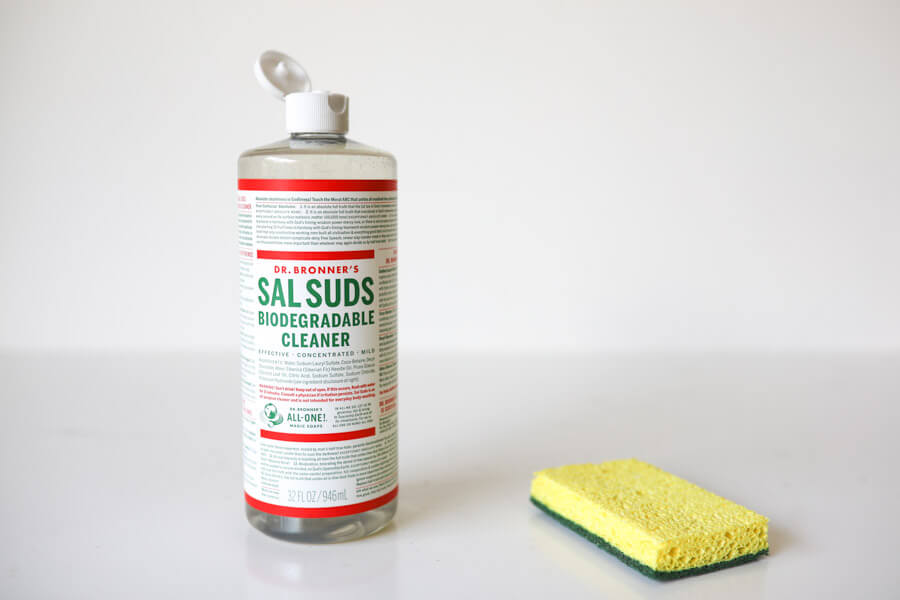
The EWG loves Dr. Bronner’s – Biodegradable Sal Suds and we do too. The EWG gave it the highest rating of an A grade, with no impact to human health or the environment except for minor concerns about skin irritation and asthma. It does contain sodium lauryl sulfate (SLS), coco-betaine and picea glauca leaf oil which are the only ingredients with a C grade. It contains Siberian fir oil which gives it its nice fragrance and only a B grade. The other five ingredients are all A grades. Overall, it looks like a saint when compared to C grade products, which are often combinations of ingredients with even worse grades.
Frankly, given it’s referred to as a biodegradable soap, we had our doubts about its potency. But Dr. Bronner’s delivered in nearly every category. It handled both oil and food stains like a champ. It has a fresh pine scent, likely due to the Siberian fir needle oil and spruce leaf oil. It didn’t foam as high as some of the other dish soaps but had enough foam to convince us it could do the job.
Cleaning dirty dishes is where it really shined. In the three-minute olive oil test, the oil slid right off the plate as we pulled it out of the sink. The plate hardly needed rinsing. And, in the baked-on food test, the food completely dissolved, falling off the plate as it was pulled from the water. The only unfortunate thing we could find is that your dishes will be done before you can read all the great and entertaining information on the label.
Apparently, washing dishes is not the only thing Dr. Bronner’s – Sal Suds is good for. It can also be used as laundry soap, an all-purpose spray cleaner, window washing spray and a vegetable wash. Because it is biodegradable, it is also the best multi-purpose soap to take camping or backpacking. Check out Lisa Bronner’s “Sal Suds Dilutions Cheat Sheet.”
Also great green pick: Puracy
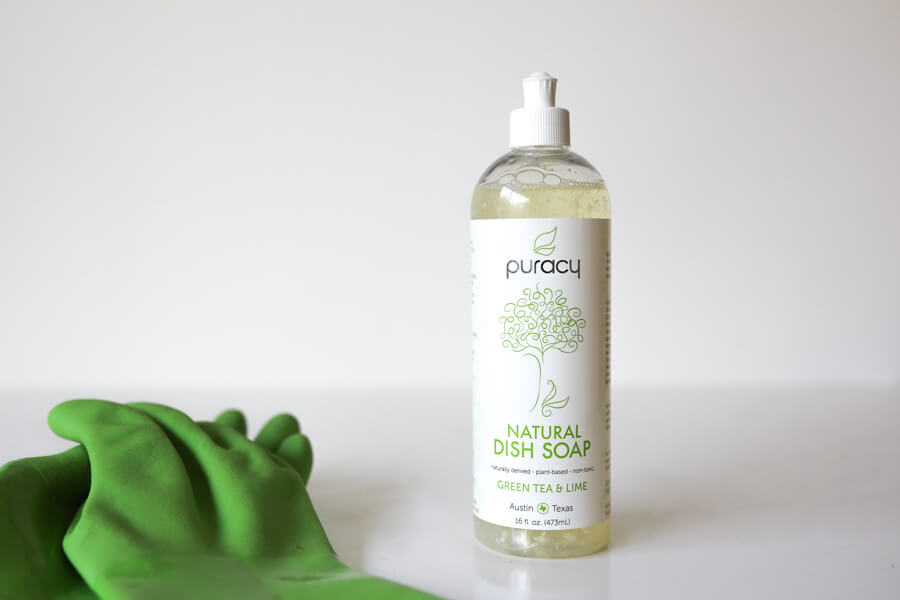
Although Dr. Bronner’s Sal Suds wins for best natural dishwashing soap, we wanted to award an honorable mention to Puracy’s natural dish soap. Like Dr. Bronner’s, Puracy also scores an A grade from the Environmental Working Group (EWG). We really liked its light and natural-smelling fragrance and there are no colors added, meaning one less thing to harm the environment or trigger sensitivities.
It was an excellent degreaser, cutting the olive oil easily. It was moderate against stuck-on food, requiring just a slight bit of scrubbing.
Puracy Natural is a good choice for those with skin or lung sensitivities. It received a great score from the EWG in those areas. It’s also one of the least harmful to the environment, scoring well in its potential for aquatic toxicity. The satisfaction you get for its human safety and its low impact on the environment is well worth the extra cost.
Budget pick: Ajax – Super Degreaser

Ajax – Super Degreaser took top honors for the cheapest dishwashing soap we tested.
We were able to find it for $.05 per ounce. Our average cost per ounce for all the dishwashing soaps we tested was $.21 and the highest price range was Dr. Bronner’s Sal Suds at $.61 per ounce.
Low cost was about the only honor we could give it, however. While it foams up nicely, it still required a bit more scrubbing to get the dishes clean, but eventually got the job done. It does have a nice yellow color and lemon scent that are quite pleasing. The scent comes from natural lemon extract, so it’s nice to know the great smell we liked is real. Reviewers on Amazon give it a 4.1 rating out of 5, so it shows many Ajax users are quite happy.
Other products we tested

Dawn – Platinum Power Clean
We really liked Dawn – Platinum Power Clean. True to its reputation, it was a terrific grease cutter. In case you didn’t know, Dawn dishwashing soap is what they use to clean the oil from animals impacted by oil spills. It cuts the grease without harming the skin. Since it’s that tough on crude oil, we knew it would have no trouble with food — and we were right.
J. R. Watkins
Like Dawn, we also really liked J. R. Watkins for its ability to cut through grease. Though it doesn’t make a lot of suds, it sent grease sliding off the plate and cut stuck-on food with ease. It had a pleasant fragrance and is quite cost-effective. However, it only scored a C grade with EWG as it is said to contain chemicals that may impact those with skin or respiratory allergies, as well as ingredients known to be toxic to aquatic animals.
Ecover
Ecover – Naturally Derived Liquid Dish Soap scored a B grade by EWG. It scored well with us too, likely because of the high EWG grade and its cleaning efficiency. Like Puracy, it was a terrific degreaser and did fine on stuck-on food. There are no colors added but they did add a fragrance. It is supposed to smell like pink geranium. We weren’t sure what that was but we were certain it shouldn’t smell like rubbing alcohol, which it did. We must be onto something since EWG gave it a D grade for fragrance, saying it contains a certain chemical that are known allergens.
Better Life
Better Life is another reportedly eco-friendly dish washing soap. Unfortunately, we couldn’t find our version in the EWG database, so we gave it the points from a C grade. Other versions of Better Life however received A grades. Regardless, it still scored high with us. Like both Dawn and J. R. Watkins, it tested great for cutting grease and removing stuck-on food. True to its claim to be unscented, we could not detect a hint of fragrance.
How we selected
Dishwashing soaps come in all varieties. So, in order to determine the best regular soap and the best eco-friendly soap, we first compiled a list of all of the most commonly-purchased dish soaps by looking at ratings and reviews on Amazon, Target and Walmart. By reading a lot of reviews, we found out what people liked or disliked, such as whether it was economical or sudsy enough or efficient or how it smells. We also read the reviews on the EWG site. More on that later.
Next, we researched and learned a bit about how dishwashing soap works so that we would understand and know what to test. Fortunately, there are a variety of online articles and blog posts about how to hand-wash dishes. Did you know you should wash your glassware first?
Through all of this research, we were able to reduce a large group of dishwashing soaps down to a manageable 14. Finally, we donned our rubber gloves and went to work individually testing each one. We looked at how effective and efficient the different brands are, along with their price and appeal.
How we tested

We gathered up our equipment for the testing. This included white ceramic plates, Scotch-Brite sponges (although we would have enjoyed the top pick in our kitchen sponge review) a thermometer for testing the water and all of the bottles of dishwashing soap. Right away, we noticed that the “feel” or consistency across all of the dish soaps was nearly the same. We originally made the hypothesis that there would be some that were thinner than others. This proved not to be true. So, we removed that from our scoring.
The senses test

We documented the color and fragrance of each dish soap. Adding color and fragrance generally means adding more chemicals. All dish soaps we tested were clear aside from Ajax (yellow), Palmolive (green) and Dawn Ultra (blue). We noticed Ajax uses what they refer to as a natural lemon fragrance, but we still aren’t sure about any added chemicals in that process as they aren’t listed.
Every consumer has their own preferences. Some prefer a soapy clean smell; others prefer a lighter touch or no scent or color at all. Therefore, we did not score these features, but instead, noted them during our testing as additional information.
Suds Test
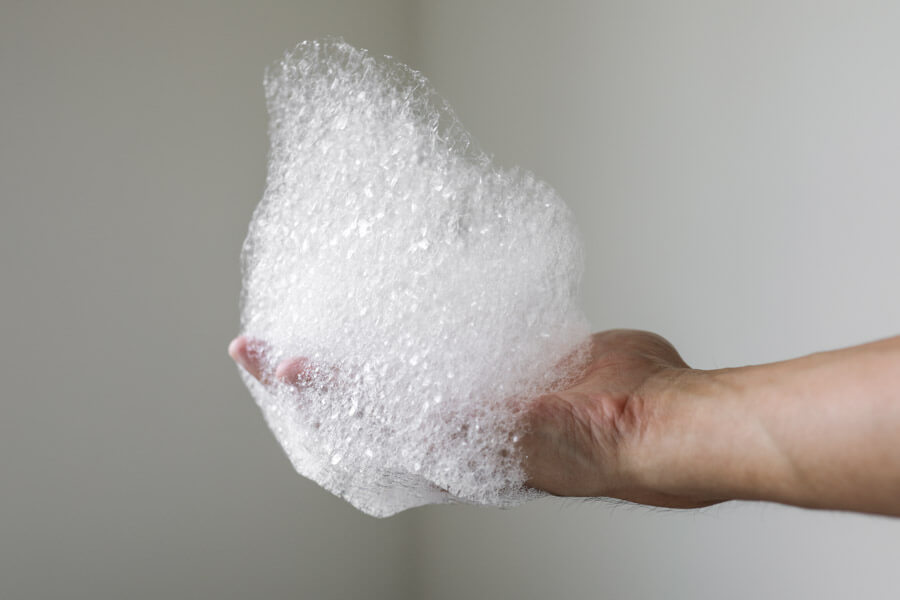
We then filled a sink with two gallons of water at 110 °F. Next, we added a teaspoon of soap liquid and stirred it up with our hand to create bubbles. We noted the amount of foam created. Surprisingly, there was quite a difference between the different soap varieties. While this may turn out to be a personal preference, we did assign a score to each one. A score of one meant no suds, a score of three meant full sink coverage, but suds only a couple of inches deep. Meanwhile, a score of five meant dense, high suds, four inches high or more.
Dishwashing can take some time so we checked the lifespan of the suds to ensure they all lasted at least 20 minutes. Dishwashing soap suds will break down faster depending on the amount of food and grease introduced. However, no particular brand’s suds seemed to break down faster or slower than another.
Olive oil test

For our third test, we spread a tablespoon of olive oil onto a white plate and submerged it in the soapy water. We let it sit for three minutes without being scrubbed. Then we pulled it out, noting how effective (or ineffective) each soap brand was at removing the oil. Our test theory was that dishwashing soaps should bind with the oil and remove it without any need for scrubbing.
Olive oil is a fairly light oil that stays liquid at any temperature above 21 °F. So it was a bit of a surprise that any dishwashing soap would struggle to remove the olive oil. However, we found that the worst dish soaps did nothing to dissolve it, leaving it on the plate nearly the same as when it went into the water. With the best dishwashing soaps, the oil slid off as we pulled the dish out of the water and the plates came out nearly squeaky clean.
Burned-on food test

For the final test, we smeared a plate with a tablespoon of baked beans and baked it in the oven at 350 °F for 20 minutes, nearly burning the food onto the plate. Our test theory suggested that the burned-on food would require some scrubbing effort, requiring us to measure the amount of effort needed to thoroughly clean the plate.
We actually thought this would be quite the challenge, but most detergents handled it surprisingly well. After soaking for five minutes, most of the larger pieces of food came off on their own. After soaking for 10 minutes, it was quite easy to wipe the rest away. As we suspected, there were a few detergents that required a little more scrubbing with our Scotch-Brite sponge to get the plate clean. These are accounted for in the scores.
Cost per ounce

We went through each dishwashing soap and calculated the cost per ounce for the best price found at either Amazon, Target or Walmart. We found the range to be anywhere from $.05 to $.61 per ounce, so it really depends on the value of the features to the user. Be mindful that prices vary constantly and that this is just a general guide.
We found that some of these Amazon soaps require purchase through Pantry or require minimum purchases for them to even sell it to you, whereas you can get away with paying a shipping fee at Target or Walmart and buy smaller quantities at sometimes better prices.
Important features to consider
Cleaning ability: Any detergent is going to cut oil and grease to a degree, but we wanted to make the test more difficult by looking at how well they cut both liquid and solid oils, as well as baked on food. In warm water (110 °F) with a teaspoon of liquid, we expect that oil and grease should dissolve and leave the dish squeaky clean. The soap should also remove dried on food without a lot of scrubbing effort.
Environmentally and health friendly: As awareness grows, more consumers are looking for ways to reduce their personal impact on the environment. Detergents, like dishwashing soap, may have chemicals such as 1,4 dioxane and phosphates that are harmful to our water sources as well as our health. Consumers have also found that certain chemicals used in cleaning products are disruptive to their health, potentially causing asthma, skin reactions, reproductive issues and even cancer.
Appeals to the senses: Let’s face it — washing dishes is a chore. We might as well look for ways to make it more enjoyable. We looked at both smell and feel to provide a helpful guide. Personal taste determines whether these traits are pleasing, as some prefer a clear soap with no fragrance and others prefer something more stimulating to the senses.
Cost per use: Lastly, all things being relatively equal, it comes down to price. These days, we all want to pinch a few pennies, so why pay more if you don’t have to? We calculated the cost per use as an additional testing metric.
How dishwashing soap works
It’s fairly well known that oil (which attracts dirt) and water don’t mix. So, manufacturers use what is known as surfactants to break up non-solubles, like oil and grease. Generally, that means either sodium lauryl ethyl sulfate (SLES) or sodium lauryl sulfate (SLS). These work by solubilizing oils so that they can be rinsed away. More specifically, surfactants like SLES and SLE break up the oil into smaller drops that become water soluble.
A single soap molecule is hydrophobic on one end and hydrophilic on the other. The hydrophobic end repels water and attaches to the oil. The hydrophilic end attracts water. When soap is mixed with the oil in the water, it binds with the dirt and oil, separating it into small drops that are easily rinsed away.
We wanted to make sure we were washing dishes correctly, so we turned to howtocleanstuff.net for advice. When washing dishes, you should fill a sink with water as warm as you can tolerate, but not any hotter. Don’t add all the items to be washed as it will soil the water and could be dangerous if there are sharp items. With the dishes stacked to the side, you should wash the items that have touched your mouth first, starting with glasses.
But, don’t put your hand inside the glass as it could break. Wash in order of least soiled and rinse each item separately with hot water. If the water gets too dirty, don’t be afraid to change it. The most sanitary way to hand-wash dishes is to use the hottest water you can stand coupled with a clean, soapy sponge and then let them air dry.
Hard vs. soft water
Approximately 85% of households in the United States have what is known as “hard water.” Hard water is identified by the number of minerals in the water, specifically calcium (Ca), magnesium (Mg), iron (Fe) and manganese (Mn). Having hard water can make it difficult to create soap suds and keep dish soap from doing its job. The minerals actually chemically interact with the surfactants in the soap, making it less effective.
If you aren’t sure whether you have hard or soft water, you can easily test it yourself using water test strips. Be sure to test both the hot and the cold water since hot water heaters can produce minerals that lead to harder water. The water strip tests for hardness from 0 to 1,000 ppm (parts per million). The American Society of Agricultural Engineers and the Water Quality Association has a degree of hardness standard that will help you determine if and how you should treat your water.
Washing dishes by hand may reduce allergens
A study published in the Journal of Pediatrics suggests that families who wash dishes by hand are less susceptible to allergies than those who use dishwashers. There is increasing evidence that a little more exposure to germs can stimulate and benefit the immune system. This is called the “hygiene hypothesis” which speculates that the rise in childhood allergies may be the result of too little exposure to bacteria early in life.
A Swedish research team surveyed over 1,000 families in Sweden with children ages seven to eight. They found that only 23% of children whose parents used hand dishwashing had a history of asthma and eczema, compared to 38% of families who used dishwashers. Yet another good reason to continue washing dishes by hand.
Why not use a dishwashing machine?
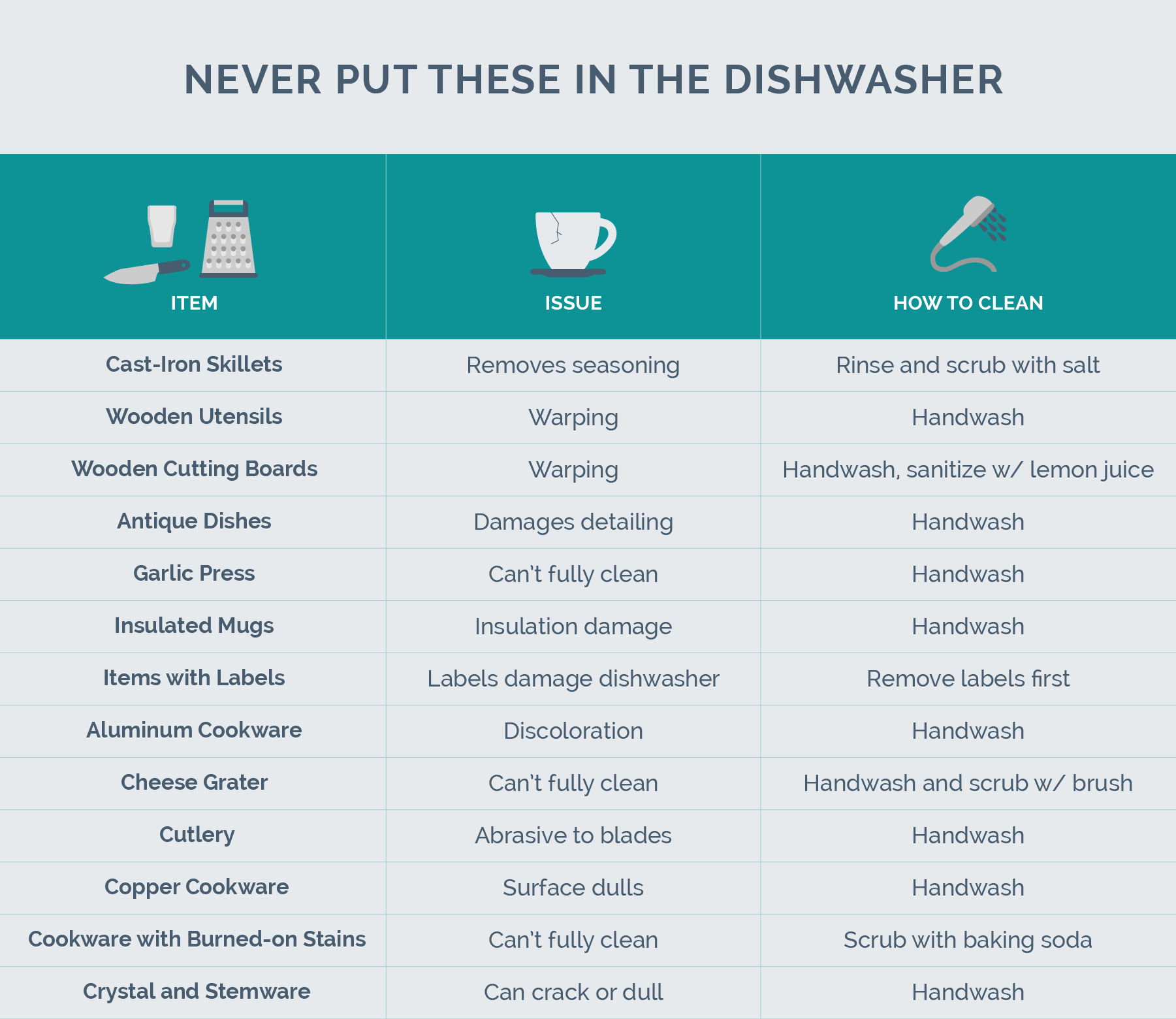
Even with the invention of the dishwasher, people continue to wash many of their dishes by hand. Some may not own a dishwasher and others actually enjoy hand-washing. But there are actually some very sound reasons for washing dishes by hand.
According to Good Housekeeping, there are 13 kitchen items that shouldn’t ever be put in the dishwasher. The dishwasher can cause damage, not clean the item thoroughly or could harm the dishwasher itself.
The EWG grade

The EWG (Environmental Working Group) is a non-profit, non-partisan organization working to help people live healthier lives in a healthier environment. Among other things, they research consumer products and rate them on their impact to human health and the environment.
They grade commonly used consumer products from A-F. They look at the ingredients to determine any chemicals known to cause skin irritations, asthma, cancer, developmental and reproductive toxicity, and harm to the environment. We have included these grades in our scoring.
The bottom line
Washing dishes by hand is not going to be completely replaced by the machine anytime soon. So, consumers should educate themselves to make sure they find the right balance of performance, pleasure, price, and impact.
More Reviews
The 9 Best Mops For Hardwood Floors
Rubbermaid - Reveal Spray Mop
DELOMO - Pet Hair Roller
SimpleHuman
The 8 Best Vacuums for Hardwood Floors
Shark - Apex
Shark - Rocket HV302
Shark - Apex
Iron Out - Stain Remover
Nexus - BD1N
The Best Aluminum Can Crushers
Dial Industries - Easy Pull


